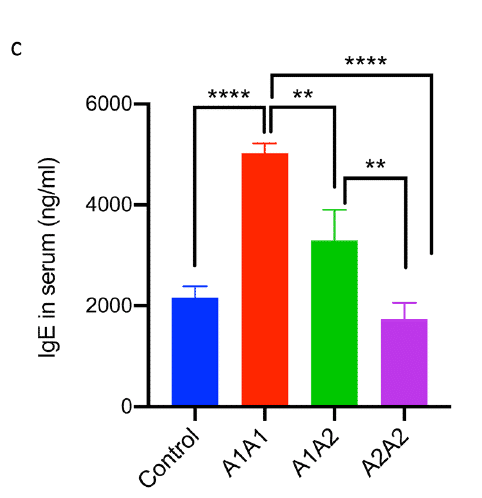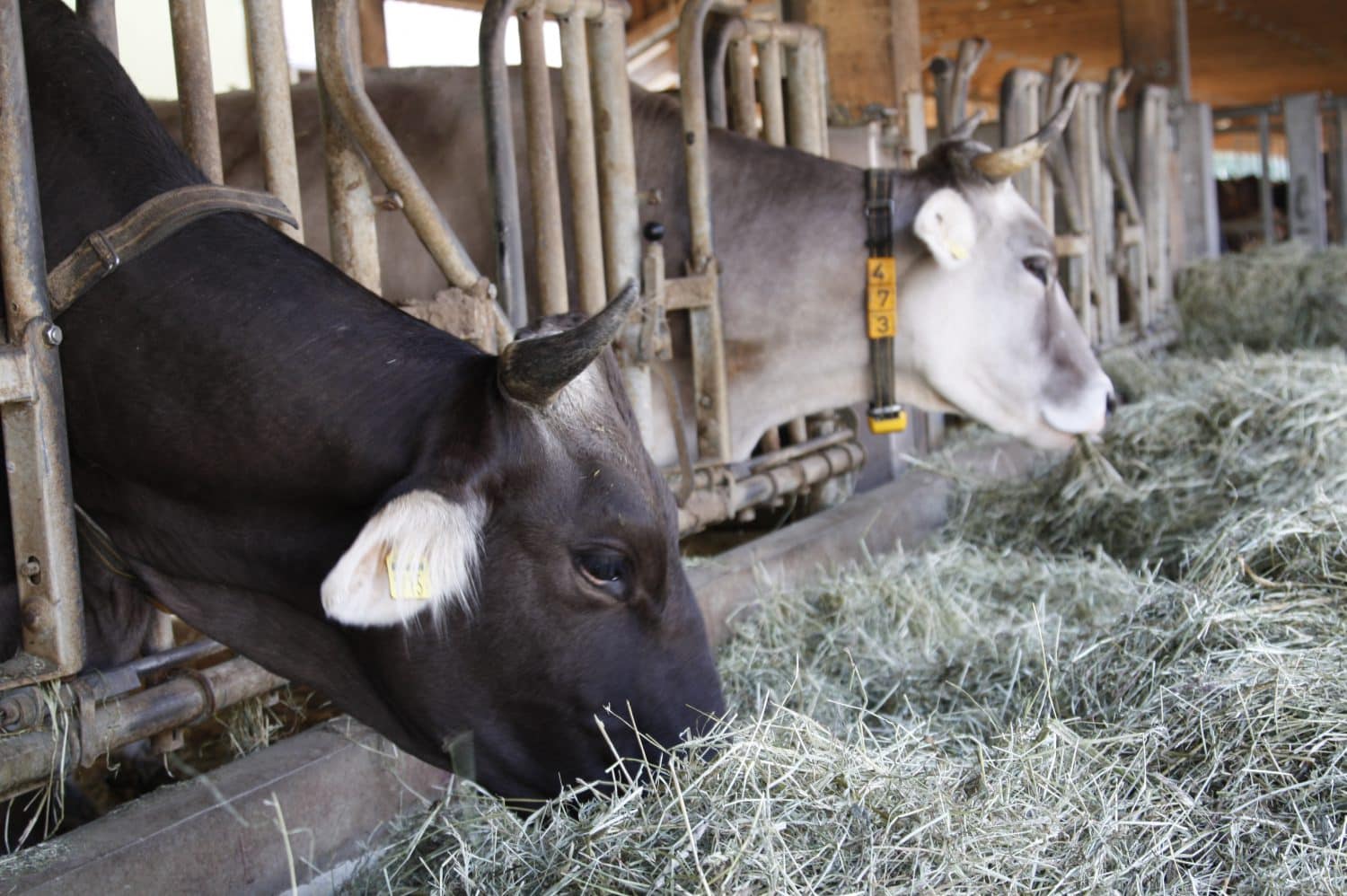Take home message
- Indian researchers have found increased asthma in mice after consumption of sterilized A1A1 genetics cow’s milk
- This asthma risk effect of A1-milk has only been found in heated milk and not in raw milk consumption.
β-casomorfine (BCM-7)
Abbring et al. (2017) have shown that to provoke asthma in mice, it matters whether you give them raw or heated milk (80oC). Mice reared with heated milk had asthmatic reactions, whereas those reared with raw milk have no asthmatic reactions. Indian researchers have further demonstrated that asthma symptoms in mice are related to the genetics of the cow producing the milk and the production of beta-casomorphin-7, so-called A1-milk (Yadav et al., 2020). Since there are two paired chromosome carrying a gene, the two genes can be identical or different. A cow can be A1A1 (homozygote A1), A2A2 (homozygote A2) or A1A2 (heterozygous). Only cows with A1-genetics produce a milk protein β-casein (BCN) containing β-casomorphin (BCM-7) that is released during intestinal digestion. BCM-7 is a peptide consisting of 7 amino acids. The difference in genetic code between A1 and A2 cows is only one-peptide small. After a single mutation in the BCN, the amino acid proline is replaced by histidine. As a result, the BCN protein is hydrolysed differently and the BCM-7 can be formed in A1 milk, but not A2 milk. BCM-7 has an opioid-like effect. New Zealander Woodford even calls BCM-7 the “Devil in the milk”.
Heated A1 or A2-milk in mice
The Yadav et al. team performed their studies with sterilized completely defatted milk, as most of milk consumed worldwide has been pasteurized or sterilized. Mice were fed A1A1, A1A2 and A2A2 milk and a control group was given water. At the end of the feeding period, asthma was measured as the air resistance in the lungs after the mice had been treated with a toxic substance (methacholine). Blood samples evaluated various immunological parameters and lungs were examined microscopically. Air resistance (as an indication of asthma) was highest in A1A1 mice group and lowest in A2A2 mice group. The A1A2 mice group was intermediate which could be due to that, the proportion of BCM modified protein produced by A1A2 cows is lower than in A1A1 animals, and this could indicate a dose-effect. Other in-vitro studies have also shown differences in release of BCM-7 depending on the cow genome (Kaminska et al., 2012). A2A2 milk releases approximately 45 ng/ml BCM-7, while for A1A1 milk this is more than 10-fold, approximately 500 ng/ml.
Overall, A1A1 fed mice exhibit inflammatory responses in various tissues, including the lung and blood. As regards immunological response in the blood of the mice, the immunoglobulin E values are interesting (Figure 1).

There is a highly significant, strong increase in IgE in the A1A1 mice group, whereas the A2A2 mice showed similar IgE as the control mice. The A1A2 mice group had intermediate IgE values. Other blood values showed similar tendencies, but also there were immunity responses with no difference between A1A2 mice group and A2A2 mice group.
Raw versus heated milk
The Indian research group (Yadav et al. 2020) evaluated only asthma effects due to sterilized milk. The Dutch research group, Abbring et al. (2017), also showed increased asthma in mice when whole unprocessed milk was heated at 80oC. So, the heated raw milk in The Netherlands elicited similar reactions when fed in India to mice as the sterilized skimmed A2A2 milk. The whole milk used by Abbring came from a dairy with 65% A1 genetics and 30% A2 genetics in their cows; thus roughly comparable to the A1A2 milk used in Yadaz study. Fed with raw milk, the (Dutch) mice did not have any asthmatic symptoms to this 65% A1 milk, and the asthma outcomes were clinically equal to the control mice (fed saline water). An important question is, if we would like to solve the outcomes through a change in genetics of our dairy cows (pure A2A2-cows) or through non-heating of milk to reduce asthma outcomes? The Abbring mice studies as well as numerous epidemiological studies in children, clearly show that any raw milk (in mice and in human) leads to the reduction of asthma, independently of the A1/A2 genetics of the cows. The asthmatic effects only arise after milk was heated. The founder of the New Zealand A2 company has acknowledged , the problems with A1 milk and the BCM-7 as an phenomenon of milk pasteurization (McLachlan, 2001). The consequences of A1 genetics in relation to human health still exists. However, the asthma risk only arises after heating. If consumed raw, there is no evidence of increased asthma risk due to the genetics of the cows.
Literature
Abbring, S., Verheijden, K. A., Diks, M. A., Leusink-Muis, A., Hols, G., Baars, T., … & van Esch, B. C. (2017). Raw cow’s milk prevents the development of airway inflammation in a murine house dust mite-induced asthma model. Frontiers in Immunology, 8, 1045.
McLachlan, C. N. S. (2001). β-casein A1, ischaemic heart disease mortality, and other illnesses. Medical Hypotheses, 56(2), 262-272.
Yadav, S., Yadav, N.D.S., Gheware, A. et al. Oral Feeding of Cow Milk Containing A1 Variant of β Casein Induces Pulmonary Inflammation in Male Balb / c Mice. Sci Rep 10, 8053 (2020). https://doi.org/10.1038/s41598-020-64997-z




